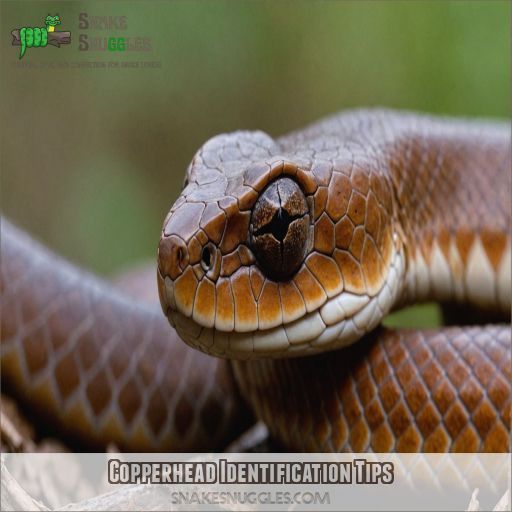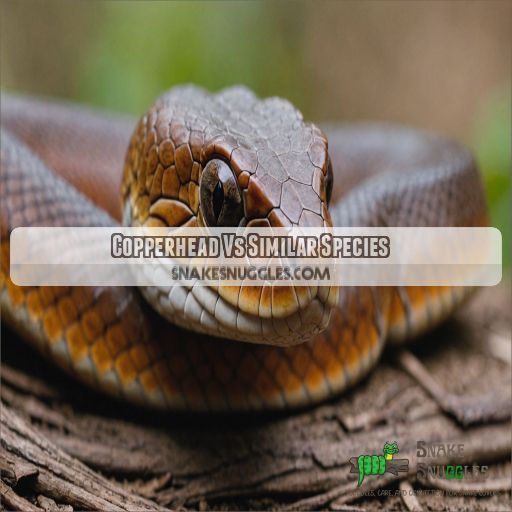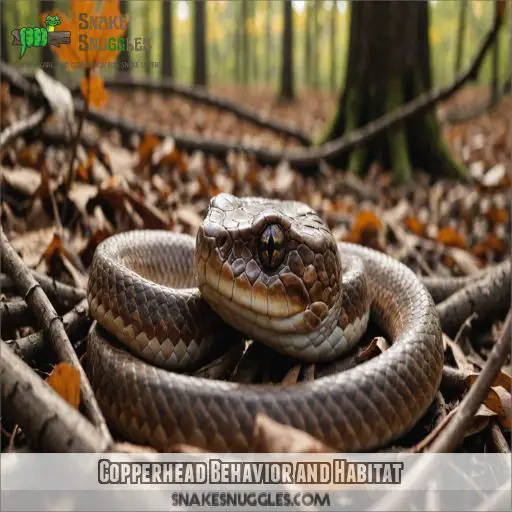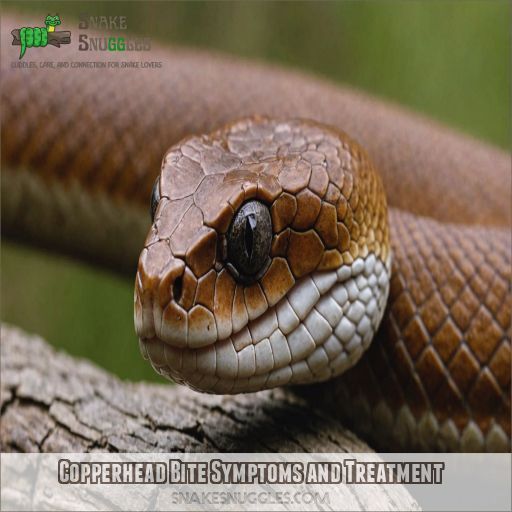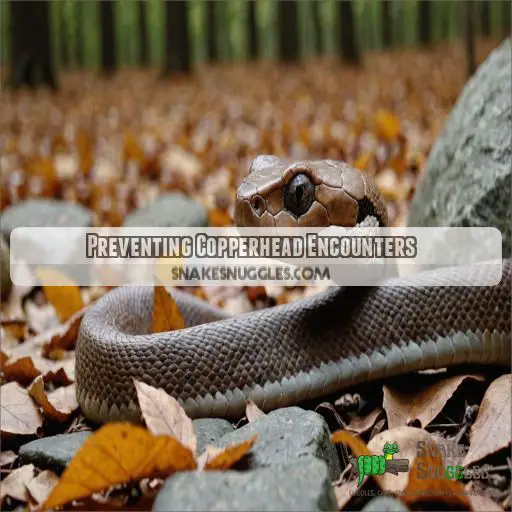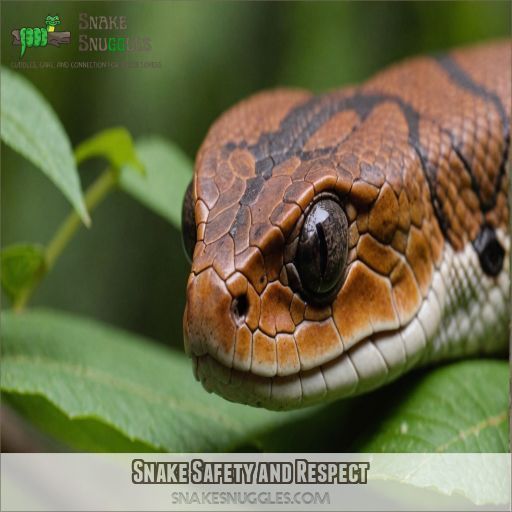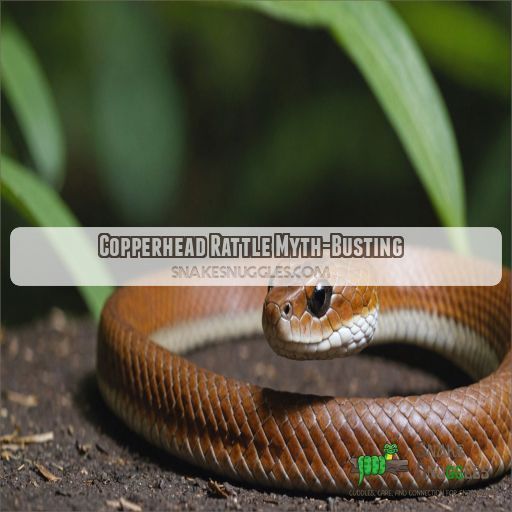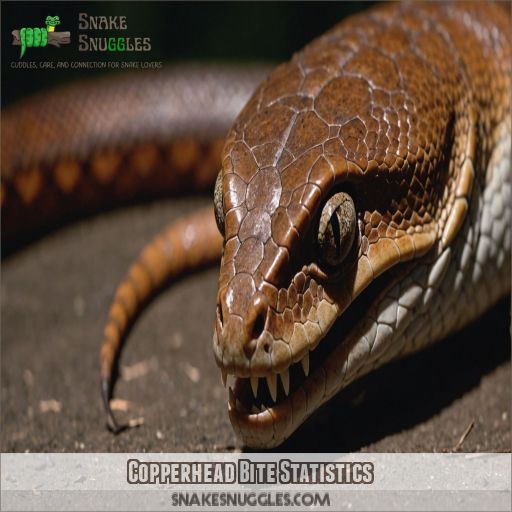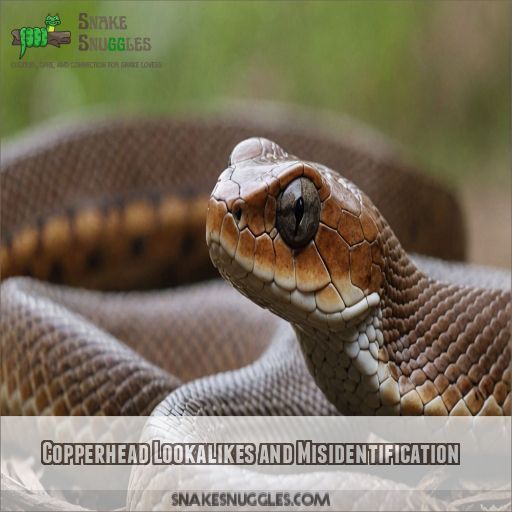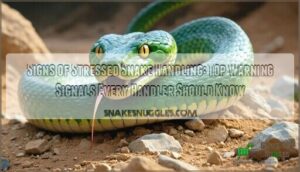This site is supported by our readers. We may earn a commission, at no cost to you, if you purchase through links.
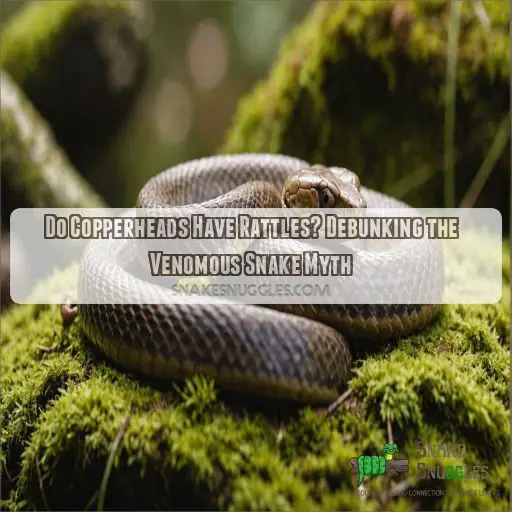 You’re wondering if copperheads have rattles? Well, the answer is no, they don’t.
You’re wondering if copperheads have rattles? Well, the answer is no, they don’t.
But here’s the thing: copperheads can vibrate their tails rapidly, making a sound that might remind you of a rattlesnake. It’s a clever trick, but don’t be fooled! Copperheads are venomous pit vipers, but they don’t have the distinctive rattle of a rattlesnake.
, but they don’t have the distinctive rattle of a rattlesnake.
If you’re out hiking or camping, you need to know the difference. So, what’s the best way to identify a copperhead? We’ll get to that in a minute. For now, just remember: no rattle doesn’t mean no danger.
Table Of Contents
- Key Takeaways
- Copperhead Identification Tips
- Copperhead Vs Similar Species
- Copperhead Behavior and Habitat
- Copperhead Bite Symptoms and Treatment
- Preventing Copperhead Encounters
- Snake Safety and Respect
- Copperhead Rattle Myth-Busting
- Copperhead Bite Statistics
- Copperhead Lookalikes and Misidentification
- What to Do in a Copperhead Encounter
- Frequently Asked Questions (FAQs)
- Can copperheads make a rattling sound?
- What snake is mistaken for a copperhead?
- How do you tell if it’s a copperhead snake?
- Do cottonmouths have rattles?
- How do copperheads adapt to different environmental conditions and climates?
- Can copperheads swim and are they found in aquatic environments?
- What are the unique characteristics of juvenile copperheads and their behavior?
- Do copperheads have a specific mating season and reproductive habits?
- How do copperheads interact with other snakes and animals in their ecosystem?
- Conclusion
Key Takeaways
- You might be surprised to learn that copperheads do not have rattles, but they can still make a pretty intimidating sound by vibrating their tails – don’t worry, it’s just a defense mechanism.
- Copperheads are often mistaken for rattlesnakes due to their similar appearance, but there are some key differences: copperheads have a coppery-tan color, a triangular head shape, and hourglass-shaped crossbands, whereas rattlesnakes have a distinctive rattle and a more diamond-shaped pattern.
- If you encounter a copperhead, stay calm and slowly back away – these snakes are generally not aggressive and prefer to avoid confrontations, but it’s still important to exercise caution and seek medical attention immediately if you are bitten.
- Copperheads are masters of disguise and can blend in with their surroundings, so it’s essential to be aware of your environment and take precautions when hiking, camping, or exploring areas where copperheads are common – wear protective clothing, stay on marked trails, and avoid tall grass and leaf litter.
Copperhead Identification Tips
When you’re out in the woods, you need to know your snakes, especially the copperhead, whose venomous bite can ruin your day (or worse). To avoid a copperhead encounter gone wrong, learn to identify these snakes by their distinctive head shape, body patterns, and eye color – your future self will thank you!
Recognizing Copperhead Head Shape
Your copperhead encounter relies on swift identification, starting with the head shape. A copperhead’s triangular head is noticeably wider than its neck, accommodating venom glands and fangs. Note the coppery-tan color and markings, a distinct feature of these pit vipers.
Identifying Copperhead Body Patterns
When identifying copperhead body patterns, you’ll notice hourglass-shaped markings. Here are key characteristics to look for:
- Hourglass markings: Wide at the top and bottom, narrow in the middle.
- Pattern variation: Markings may be dark brown or reddish-brown.
- Body color: Coppery-tan with a camouflage effect.
- Color consistency: Patterns are usually consistent, but may vary in intensity.
Distinguishing Copperhead Eyes
When identifying copperheads, take a closer look at their eyes. They’ve yellow eyes with black, vertical, elliptical pupils. Here’s a quick reference guide:
| Eye Characteristic | Description |
|---|---|
| Color | Yellow |
| Pupil Shape | Vertical, elliptical |
| Size | Medium-sized |
Understanding Copperhead Camouflage
You’re on a hike, and suddenly, you spot a snake. But wait, where’s the rest of it? Copperheads are masters of disguise, blending in with their surroundings like pros. Here are some reasons why:
- Their coppery-tan color helps them merge with fallen leaves and twigs.
- The hourglass-shaped crossband pattern breaks up their body shape, making them less visible.
- They often hide in woodpiles, under rocks, or in dark crevices.
- Solar lights can create shadows, making it harder to spot them.
- Copperheads freeze in place when threatened, relying on their camouflage to protect them.
Copperhead Vs Similar Species
You’re out in the woods, and you spot a snake that looks suspiciously like a copperhead – but how can you be sure it’s not a harmless lookalike? Let’s break down the key differences between copperheads and their common impostors, Let’s break down the key differences between copperheads and their common impostors, like nonvenomous pet snakes, juvenile rat snakes, and northern water snakes, to help you make a confident ID.
, juvenile rat snakes, and northern water snakes, to help you make a confident ID.
Differences Between Copperheads and Corn Snakes
| Feature | Copperhead | Corn Snake |
|---|---|---|
| Coloration | Coppery-tan | Redder, with square markings |
| Head Shape | Triangular | Narrow, pointed |
| Habitat | Woodpiles, garages | Fields, forests |
| Venom | Yes | No |
| Diet | Small mammals | Rodents, birds |
Now you can confidently identify these slithery friends!
How to Tell Apart Copperheads and Juvenile Rat Snakes
When comparing copperheads to juvenile rat snakes, it’s easy to get confused. But, take a closer look:
- Pupil shape: Copperheads have vertical, elliptical pupils, while rat snakes have round ones.
- Head shape: Copperheads have a triangular head, whereas rat snakes have a more slender one.
- Body pattern: Copperheads have hourglass-shaped markings.
- Tail differences: Copperheads lack a yellow tail, unlike some rat snakes.
Northern Water Snakes Vs Copperheads
When it comes to Northern Water Snakes vs Copperheads, it’s easy to get confused. Here’s a quick rundown:
| Snake | Habitat | Markings |
|---|---|---|
| Northern Water Snake | Aquatic, near rivers/lakes | Dark blotches, narrow on sides |
| Copperhead | Woodpiles, garages, covered areas | Hourglass-shaped crossbands |
| Northern Water Snake | Fish, frogs, small aquatic animals | No constriction band |
| Copperhead | Small mammals, insects | Triangular head, yellow eyes |
Don’t worry, with practice, you’ll become a pro at identifying these slithery friends!
Copperhead Behavior and Habitat
As you explore the outdoors, you need to understand copperhead behavior and habitat to minimize the risk of encounters. By knowing their activity patterns, temperature preferences, and common hiding spots, you’ll be better equipped to avoid these venomous snakes and enjoy the great outdoors with confidence.
Understanding Copperhead Aggression Levels
Regarding copperhead aggression, you might be surprised. Copperheads aren’t typically aggressive, but they’ll defend themselves if necessary. Here are some key things to know:
- They tend to avoid confrontations with humans and larger animals.
- Defensive behavior is usually triggered by feeling threatened or cornered.
- Prey avoidance is their top priority, not attacking you.
Copperhead Activity Patterns and Temperature Preferences
Let’s talk about copperhead activity patterns and temperature preferences. Copperheads are most active during warm weather, typically between May and October. They thrive in temperatures around the 80s and tend to seek cooler spots when it gets too hot. During this time, they’re more active at night, but can be spotted during the day as well.
Common Places to Find Copperheads
Now that we’ve covered copperhead temperature preferences, let’s talk about where you might encounter them. Copperheads often hang out near water, under debris, in wooded areas, gardens, and even your own yard! They love hiding in woodpiles, under rocks, or near a cozy blacktop road. Keep an eye out, especially in areas where northern water snakes are common.
Copperhead Bite Symptoms and Treatment
As you’re out enjoying the warm weather, it’s important to know what to do if you encounter a copperhead, especially if you’re unlucky enough to get bitten. Let’s explore the symptoms of a copperhead bite and the best treatment options, so you can stay safe and healthy in copperhead country.
Recognizing Copperhead Bite Symptoms
If you’re bitten by a copperhead, you’ll likely experience:
- Severe pain at the bite site
- Swelling and bruising around the wound
- Numbness or tingling in the face or extremities
Act fast and seek medical attention to minimize copperhead venom effects, especially in South Carolina where copperheads are common.
Understanding Dry Bites and Venom Injection
When a copperhead bites, you might expect a massive venom injection, but surprisingly, about 10% of bites are "dry bites" with no venom released. Why the variation? It’s due to the snake’s control over venom release.
| Bite Type | Venom Amount | Severity |
|---|---|---|
| Dry Bite | 0 | Low |
| Venomous Bite | variable | Medium-High |
| Severe Bite | high | High |
Understanding this unpredictability can save you from panic and prompt proper action.
Effective Treatment Options for Copperhead Bites
If you’re bitten by a copperhead, seek medical attention ASAP! Antivenom administration is the most effective treatment. Here’s what you should know:
- Don’t try home remedies, they often worsen the situation.
- Pain management is key, but don’t overdo it.
- First aid should focus on keeping the affected area still.
- Bite severity determines treatment, so let a doc assess it.
Preventing Copperhead Encounters
As you head outdoors, As you head outdoors, you’ll want to take some simple precautions to avoid copperhead encounters and understand copperhead snake risks – after all, an ounce of prevention is worth a pound of antivenom.
, an ounce of prevention is worth a pound of antivenom! By being aware of your surroundings, wearing the right gear, and steering clear of copperhead habitats, you can minimize your chances of a close encounter with these slithery creatures.
Safety Precautions for Outdoor Activities
When venturing outdoors, take a few simple precautions to avoid copperheads. Wear long pants, long-sleeved shirts, and closed-toe shoes, especially when hiking or camping. Stay on marked trails and avoid tall grass and leaf litter. Use a flashlight at night and consider carrying a walking stick to probe ahead, just in case.
Avoiding Copperhead Habitats and Hiding Spots
When exploring the great outdoors, you’ll want to steer clear of copperhead habitats and hiding spots. Avoid woodpiles, rocky areas, and under covered spots like grills or decks. Keep your yard tidy, removing leaf litter and debris. By being mindful of these copperhead-prone areas, you’ll minimize the risk of an unwanted encounter.
Importance of Wearing Protective Clothing
When venturing into copperhead territory, don your armor – literally! Wearing protective clothing like long pants, long-sleeved shirts, and closed-toe shoes can be a lifesaver. Hiking boots are a must, as they provide a sturdy barrier between your feet and potential snakebites. Don’t sacrifice style for safety; choose clothing that’s both comfortable and protective.
Snake Safety and Respect
When you’re out and about in copperhead country, you need to be aware of your surroundings and keep an eye out for these masters of disguise. By being mindful of your environment and avoiding unnecessary interactions with snakes, you can minimize the risk of a copperhead encounter gone wrong.
Being Aware of Your Surroundings
When exploring the great outdoors, remember that copperheads often blend in with their surroundings. As you’re taking those hiking safety precautions, keep an eye out for snakes in woodpiles, under rocks, and near streams. Regular yard checks can also help you spot unwanted slithery guests. Stay vigilant and aware of your surroundings to minimize copperhead encounters.
Avoiding Unnecessary Interactions With Snakes
With snakes, it’s best to admire them from a safe distance. Most snakes, including copperheads, aren’t aggressive and will avoid interactions. To minimize encounters:
- Wear protective clothing, like long pants and boots, when hiking or working in snake habitats.
- Avoid reaching into dark or hidden areas.
- Never pick up a snake, even if you think it’s harmless.
Seeking Medical Attention for Snake Bites
You’ve been bitten by a snake – now what? Stay calm and seek medical attention ASAP. Don’t believe the myth that all snake bites are dangerous and deadly; instead, get to a hospital where antivenom is available.
; instead, get to a hospital where antivenom is available. Medical professionals will assess bite severity and provide proper treatment. Remember, prompt care is key to a full recovery.
Copperhead Rattle Myth-Busting
As you explore the outdoors, you might wonder if copperheads, those venomous snakes common in South Carolina, can rattle like their more infamous cousins, the rattlesnakes. Let’s set the record straight: copperheads don’t have a rattle, and it’s time to debunk this myth and learn how to identify these snakes safely.
Can Copperheads Make a Rattling Sound?
Copperheads can’t make a rattling sound.
Unlike rattlesnakes, copperheads don’t have a rattle.
Instead, they’ll often hiss or vibrate their tail when threatened.
This can be pretty intimidating, but don’t worry, it’s just a defense mechanism.
Why Copperheads Are Often Mistaken for Rattlesnakes
When wandering through the woods, you might mistake a copperhead for a rattlesnake – and you’re not alone! The confusion likely stems from their similar appearance and the myth that copperheads can rattle. Here are three key reasons why copperheads are often mistaken for rattlesnakes:
- Similar body shape: Copperheads and rattlesnakes have heavy, stocky bodies with a triangular head shape.
- Pattern confusion: Both snakes have distinctive patterns, which can be misidentified.
- Lack of rattle awareness: Not knowing that copperheads don’t rattle can lead to mistaken identity.
Copperhead Bite Statistics
You’re probably curious about the actual danger posed by copperheads, so let’s take a look at the numbers: copperhead bites are most common during the warmer months, with a significant spike in May, June, and July. In areas like Central Virginia, copperhead bites are on the rise, making it essential to stay informed and prepared when venturing outdoors.
Number of Copperhead Bites Per Month
Now that we’ve busted the copperhead rattle myth, let’s get down to business: understanding copperhead bite trends. You’re probably wondering when these slithery creatures are most likely to strike. According to data, copperhead bites peak in May, June, and July, with most incidents occurring in warm weather. Here’s a breakdown of copperhead bite stats:
| Month | Number of Bites | Bite Severity |
|---|---|---|
| May | 25 | Moderate to Severe |
| June | 30 | Severe |
| July | 20 | Moderate |
Stay safe, and stay informed!
Regions With High Copperhead Bite Incidents
You’re more likely to encounter copperheads in certain regions. When we look at copperhead bite statistics, some areas stand out. The southeastern United States is home to a large number of copperhead bites, particularly in:
- Central Virginia, where bites peak in May, June, and July
- South Carolina, South Carolina, where copperhead snake facts are the most common venomous snake.
- Appalachian regions, where the snakes thrive in wooded, rocky terrain
Copperhead Lookalikes and Misidentification
As you’re learning to identify copperheads, you need to know which snakes are often mistaken for them – after all, you don’t want to panic over a harmless lookalike. By recognizing the distinct features of copperheads and their doppelgangers, you’ll become a pro at telling them apart and stay safe in snake country.
Snakes Commonly Mistaken for Copperheads
You’re on high alert for copperheads, but don’t want to mistake a harmless lookalike for the real deal.
Corn snakes, with their redder hues and square-shaped markings, are often mistaken for copperheads.
Juvenile rat snakes also get confused with copperheads due to their blotchy patterns, but their round pupils are a giveaway.
Northern water snakes, with their dark blotches, are another common mix-up.
Brush up on your Snake Identification Characteristics to tell these copperhead lookalikes apart.
.
How to Tell if It’s a Copperhead Snake
Now that you know which snakes are often mistaken for copperheads, let’s get down to business: identifying the real deal.
To tell if it’s a copperhead snake, look for that distinctive coppery-tan color, triangular head, and hourglass-shaped crossbands.
Don’t forget those piercing yellow eyes with vertical pupils!
Copperheads are masters of disguise, so take your time and examine the snake carefully.
What to Do in a Copperhead Encounter
If you encounter a copperhead, stay calm and slowly back away – these snakes are generally not aggressive and prefer to avoid confrontations. If you’re bitten, seek medical attention immediately, and try to remember as many details as possible about the snake and the incident to help with treatment.
Staying Calm and Safe Around Copperheads
Breathe easy – copperheads aren’t typically aggressive, but it’s still important to exercise caution.
If you encounter one, freeze and assess the situation.
Back away slowly, giving the snake a wide berth.
Avoid sudden movements, as this can provoke a strike.
Keep a safe distance and try not to block the snake’s path.
First Aid and Medical Attention for Copperhead Bites
You’ve been bitten by a copperhead – now what? Stay calm and follow these steps:
-
- Remove any constricting items: Loosen tight clothing, jewelry, or watches that may constrict the affected area.
-
- Keep the affected limb below heart level: This can help slow down the spread of venom, if any was injected.
-
- Seek medical attention ASAP: Antivenom is the most effective treatment for copperhead bites, and prompt medical attention can reduce the risk of complications.
Frequently Asked Questions (FAQs)
Can copperheads make a rattling sound?
You’re wondering if copperheads can make a rattling sound? While they don’t have a traditional rattle like rattlesnakes, copperheads can vibrate their tails to create a buzzing or rattling noise, especially when threatened or disturbed (Source).
What snake is mistaken for a copperhead?
When you’re out and about in South Carolina, be careful not to mistake a harmless snake for a copperhead! Corn snakes, juvenile rat snakes, and northern water snakes are often mistaken for these venomous critters.
How do you tell if it’s a copperhead snake?
To identify a copperhead, look for a coppery-tan color, triangular head, hourglass-shaped crossbands, and yellow eyes with vertical pupils. Check for a heavy, stocky body and a pronounced head – if you see these features, it’s likely a copperhead!
Do cottonmouths have rattles?
With snakes, it’s a ‘rattle or hum’ situation – either they’ve got it or they don’t! Cottonmouths, also known as water moccasins, don’t have rattles, so you won’t hear them coming.
How do copperheads adapt to different environmental conditions and climates?
You’ll find copperheads thriving in diverse climates and environments, from forests to wetlands, and even urban areas . They adapt by changing their behavior, such as shifting from daytime to nighttime hunting during hot summer months (Source).
Can copperheads swim and are they found in aquatic environments?
Copperheads account for more snakebite incidents than any other venomous North American species (Source). In regard to swimming, copperheads can swim, but they’re not as comfortable in water as other snakes .
What are the unique characteristics of juvenile copperheads and their behavior?
When you’re trying to identify juvenile copperheads, look for a bright yellow or greenish tail, which they use to lure prey . These young snakes are also more likely to vibrate their tails to mimic a rattlesnake .
Do copperheads have a specific mating season and reproductive habits?
You’re wondering about copperheads’ mating season and reproductive habits? Well, copperheads breed in the spring and fall, with a gestation period of 3-9 months, and females give birth to 4-7 live young, called snakelets .
How do copperheads interact with other snakes and animals in their ecosystem?
As you venture into copperhead territory, imagine a delicate dance of coexistence. Copperheads interact with other snakes and animals in a subtle game of hide-and-seek, respecting each other’s space, and striking only when threatened or hungry.
Conclusion
Copperheads are venomous snakes, but they don’t have rattles.
You should respect their space when hiking, camping, or exploring.
Stay calm, stay informed, and stay safe.
Your adventure awaits!

